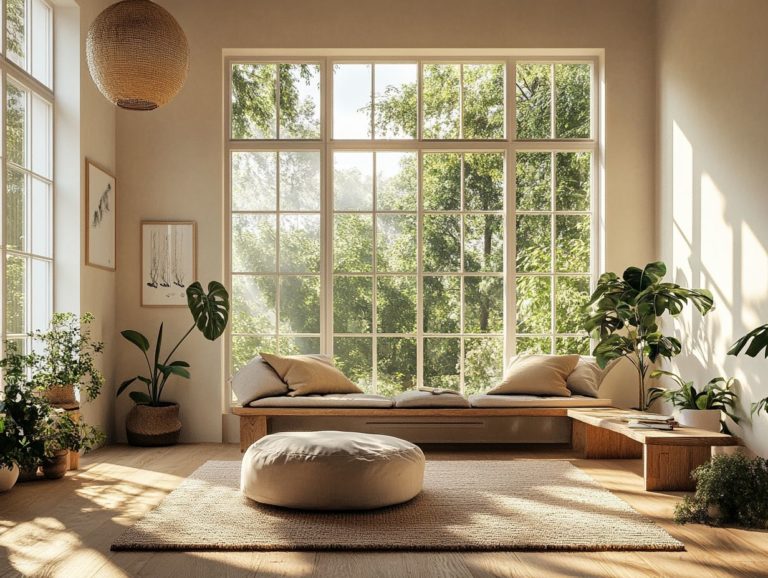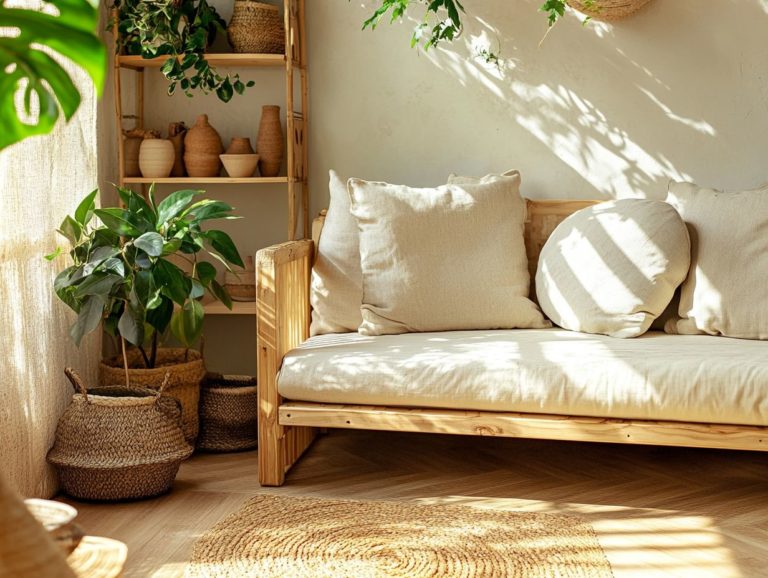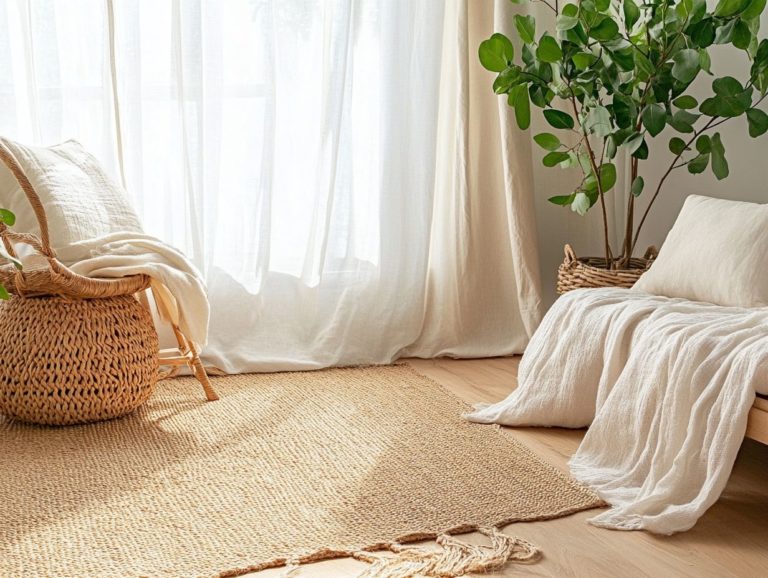The Best Sustainable Material Brands for Homes
As the world increasingly embraces environmental consciousness, you may notice a growing demand for sustainable materials in home design.
This article delves into eco-friendly options, from bamboo and cork to recycled glass and reclaimed wood. Each of these materials enhances the beauty and functionality of your home while benefiting the planet.
Explore their advantages, practical applications, where to source them, and the long-term cost savings they provide. Discover how selecting sustainable materials can transform your living space and safeguard the environment for future generations.
Contents
- Key Takeaways:
- 1. Bamboo
- 2. Cork
- 3. Recycled Glass
- 4. Reclaimed Wood
- 5. Organic Cotton
- 6. Hemp
- 7. Linoleum
- 8. Recycled Plastic
- 9. Wool
- 10. Soy-Based Foam
- 11. Natural Stone
- 12. Salvaged Metal
- 13. Recycled Rubber
- 14. Sustainable Paint
- 15. Eco-Friendly Insulation
- What Makes These Materials Sustainable?
- Frequently Asked Questions
- What are some popular sustainable material brands for homes?
- What makes these brands stand out in terms of sustainability?
- Are these sustainable material brands affordable?
- Can I use these materials for any home renovation or construction project?
- How do I know if a brand is truly sustainable?
- What are the benefits of choosing sustainable materials for my home?
Key Takeaways:

- Use bamboo, cork, and reclaimed wood to create stylish floors and furniture.
- Incorporate recycled glass, plastic, and rubber for stunning countertops and tiles.
- Choose organic cotton, hemp, and wool for luxurious bedding and textiles.
1. Bamboo
Bamboo is a great eco-friendly material for construction. With its rapid growth, impressive strength, and versatility, it serves as a carbon-negative alternative in building.
Choosing this renewable resource helps reduce carbon emissions and supports innovative designs thanks to its lightweight nature. As the demand for sustainable architecture rises, architects and builders are eager to minimize their environmental impact while maximizing aesthetic appeal.
Bamboo can withstand substantial loads, making it perfect for both structural and decorative uses. Its astonishing growth up to three feet in a single day ensures a consistent supply for your projects without exhausting resources.
Architects are now creatively integrating bamboo into diverse designs that wow everyone, from residential homes to public buildings. A prime example is the ‘Green School’ in Bali, which utilizes bamboo extensively for its eco-friendly structure. Beyond durability and flexibility, bamboo offers unique aesthetics that allow designers to push creative boundaries while staying true to sustainable practices.
2. Cork
Cork, harvested from cork oak trees, is celebrated for its natural insulation properties and eco-friendly construction attributes, making it ideal for energy-efficient buildings.
The regenerative harvesting of cork ensures the trees stay healthy while continuing to absorb carbon dioxide. This significantly reduces waste and contributes to environmental preservation. Such a sustainable approach minimizes ecological impact and yields a versatile product with excellent acoustic properties, perfect for soundproofing in homes and offices.
Brands like Granorte and Mixtura are leading the charge in harnessing cork s potential, offering innovative solutions that seamlessly blend sustainability with aesthetics. They show that eco-friendly choices can be both stylish and functional, elevating the standard for conscious living.
3. Recycled Glass
Recycled glass is a transformative sustainable building material, allowing you to leverage recycling to minimize environmental impact while enhancing your design both aesthetically and functionally.
This innovative resource diverts waste from landfills and plays a significant role in stunning architectural elements. By integrating recycled glass into your projects, you can create durable and beautiful surfaces like tiles and countertops that are also easy to maintain.
The versatility of recycled glass allows it to be shaped into various decorative features, adding a unique touch to any space. Its lightweight nature and thermal properties significantly contribute to energy-efficient construction, making it an eco-friendly choice that resonates with designers and environmentally-conscious consumers.
Choosing these sustainable materials today can lead to a greener future. Take the next step: research more about these eco-friendly options and consider incorporating them into your designs!
4. Reclaimed Wood
Reclaimed wood is a premier sustainable building material that embodies the principles of waste recycling, infusing character and history into contemporary sustainable architecture.
When you source reclaimed wood, you re salvaging timber from decommissioned structures like barns, factories, and warehouses. These materials might otherwise be neglected and left to deteriorate.
This practice not only preserves valuable natural resources but also significantly reduces the embodied carbon footprint compared to using virgin lumber.
Each piece boasts its own unique story, showcasing distinctive grains, colors, and textures shaped by years of aging and exposure to the elements.
Designers skillfully incorporate reclaimed wood into various applications, from exquisite hardwood floors and custom cabinetry to eye-catching accent walls and furniture pieces, enhancing both aesthetic appeal and ecological integrity.
5. Organic Cotton
Organic cotton is quickly becoming a rising star as a sustainable building material, especially in eco-friendly construction. Its biodegradable properties and potential as an insulation material are increasingly being recognized.
This trend signifies a crucial shift towards more environmentally responsible practices in the construction industry.
Choosing organically cultivated cotton not only reduces pesticide use but also nurtures healthier ecosystems with minimal disruption to local wildlife.
The carbon footprint of traditional cotton farming is significantly larger due to reliance on synthetic fertilizers and harmful chemicals.
In contrast, opting for organic cotton cultivation leads to reduced carbon emissions, offering a more sustainable alternative.
Its uses extend beyond insulation; the fabric can also be crafted into various textiles, enhancing design aesthetics while supporting eco-conscious choices.
6. Hemp
Hemp is quickly becoming a top choice among sustainable building materials, particularly in its versatile form known as hempcrete, a building material made from hemp that provides great insulation.
This innovative material is celebrated for its environmentally friendly benefits and exceptional thermal properties.
As you embrace greener practices, cultivating hemp presents an enticing opportunity to reduce carbon footprints in construction.
This remarkable plant grows rapidly and absorbs substantial amounts of CO2 from the atmosphere throughout its growth cycle.
In building applications, hempcrete shines as an ingenious insulation solution, marrying strength with lightweight materials to enhance energy efficiency.
Its capacity to regulate indoor humidity levels contributes to a healthier living environment, while the natural composition of hemp ensures it remains biodegradable.
This not only mitigates waste but also champions sustainable practices across the construction industry.
7. Linoleum

Linoleum stands out as an eco-friendly flooring option made from natural materials, establishing itself as a sustainable building material in the construction industry.
This versatile flooring is primarily composed of linseed oil, cork dust, wood flour, and natural resins, all meticulously blended to create a resilient surface.
The production process involves pressing these ingredients onto a backing material, yielding sheets or tiles that can be effortlessly installed in numerous settings.
Its impressive durability allows linoleum to withstand heavy foot traffic and resist wear, making it an excellent choice for both residential and commercial spaces.
Maintenance is simple; you typically just need to sweep regularly and mop occasionally with a damp cloth.
Thanks to its composition of renewable resources, linoleum is valued as an alternative building material that aligns with energy-efficient construction practices, ultimately contributing to a reduced carbon footprint.
Now is the time to embrace sustainable materials like reclaimed wood and organic cotton!
8. Recycled Plastic
Recycled plastic is a high-quality, eco-friendly material that tackles issues of waste and carbon emissions. It provides innovative solutions for your eco-friendly construction projects.
This material reshapes your approach to building structures. It comes in various forms, such as plastic lumber, insulation, and piping. Its durability ensures that your constructions last, minimizing the need for frequent replacements.
Recycled plastic is versatile and offers many applications, whether for residential homes or public infrastructure. For example, projects that incorporate recycled plastic in bridge construction demonstrate exceptional performance while significantly reducing the overall environmental footprint of the construction process.
By embracing recycled plastics, you can contribute to a substantial shift towards sustainability. This paves the way for greener building practices and a brighter future!
9. Wool
Wool is a stunning and enduring choice that embodies sustainable building practices. It offers exceptional thermal properties while being both biodegradable and renewable.
This remarkable material keeps your home cozy during chilly seasons and helps regulate indoor moisture. It contributes to a healthier living environment, trapping air effectively for efficient thermal performance.
Wool can lead to significant reductions in your energy costs. Plus, its inherent fire resistance makes it a safer choice compared to many synthetic options that can release harmful fumes when exposed to flames.
As the demand for eco-friendly insulation grows, wool’s versatility shines in applications from residential homes to commercial buildings. It establishes itself as a premier alternative in sustainable construction.
10. Soy-Based Foam
Soy-based foam is a revolutionary sustainable building material that enhances energy-efficient construction. Its eco-friendly insulation properties effectively reduce overall carbon emissions in buildings.
This innovative solution minimizes heat transfer and significantly decreases energy consumption by maintaining optimal indoor temperatures. Compared to traditional insulation materials like fiberglass or cellulose, soy-based foam excels with superior thermal performance.
It maximizes energy savings for both homeowners and businesses. In various building projects whether residential homes or commercial facilities its adaptability allows for seamless application in walls, roofs, and even crawl spaces.
By opting for soy-based foam, you contribute to environmentally friendly practices while ensuring comfortable living or working conditions for everyone involved.
11. Natural Stone
Natural stone is a stunning and enduring choice that enhances any building project. It is celebrated for its durability and aesthetic charm.
Sourced directly from the earth, this remarkable resource has a significantly lower environmental impact than synthetic alternatives. These often require extensive processing and energy consumption.
In sustainable architecture, natural stone shines in its versatility. It serves as both a structural element and an exquisite finish, infusing character and elegance into various design features.
Architects and builders recognize its ability to blend seamlessly with the environment. This crafts spaces that are not only functional but also visually stunning and ecologically responsible.
12. Salvaged Metal
Salvaged metal is a fantastic sustainable building material. It turns waste into valuable resources, promoting recycling efforts in construction.
Start by sourcing metal from decommissioned structures or industrial scrap yards. Even old consumer goods can be salvaged.
Using salvaged metal cuts down on carbon emissions from new materials. It s strong, durable, and perfect for both structural elements and stylish designs.
13. Recycled Rubber
Recycled rubber is an exciting sustainable building material. It turns waste into practical solutions for modern construction.
This material is versatile. It works wonderfully for flooring, roofing, and insulation.
Choosing recycled rubber reduces the carbon footprint of traditional materials. It offers stylish, durable solutions that support sustainability.
14. Sustainable Paint

Sustainable paint is crucial for eco-friendly construction. It provides low-VOC options that lower carbon emissions and beautify your spaces.
These paints improve air quality and create healthier environments by reducing harmful pollutants. Brands like Benjamin Moore s Natura and Sherwin-Williams’ Harmony offer stunning, sustainable options.
By choosing eco-friendly paints, you enjoy vibrant colors while reducing your environmental impact. It’s a smart choice for anyone who values responsible manufacturing.
15. Eco-Friendly Insulation
Eco-friendly insulation materials are key to sustainable building. They provide excellent thermal properties while reducing construction’s environmental impact.
These materials come in various forms. Cellulose, made from recycled newspapers, and wool, offer outstanding natural insulation.
Materials like cork and hemp are popular because they are renewable. Using them helps create a greener planet while lowering your utility bills.
What Makes These Materials Sustainable?
The sustainability of building materials depends on several key factors, including their sourcing, production processes, and the environmental impact they have during use. This understanding is vital as it guides your decisions in the construction industry towards eco-friendly practices.
When considering sustainable materials, look for attributes like renewable sourcing, which emphasizes the use of resources that replenish naturally, and low embodied carbon, which ensures minimal greenhouse gas emissions throughout the material’s lifecycle. Emphasizing minimal waste generation enhances resource efficiency and aligns with a circular economy, a system where resources are reused and recycled to minimize waste.
For builders and architects, grasping these concepts is essential. Lifecycle assessments are crucial in evaluating long-term environmental impacts, while certifications provide credibility and assurance that the materials you choose meet stringent sustainability standards.
This comprehensive approach gives you the power to make responsible choices that benefit both the planet and the communities you serve.
How Can These Materials Benefit the Environment?
Using sustainable building materials can greatly benefit the environment! They help cut carbon emissions, recycle waste, and conserve natural resources throughout the construction process.
These materials lower energy consumption by enhancing insulation and creating more energy-efficient buildings. Take the Bullitt Center in Seattle; it’s celebrated as one of the greenest commercial buildings in the world. It showcases how recycled materials can minimize landfill waste while improving indoor air quality through natural ventilation and non-toxic finishes.
The Edible Schoolyard Project in Berkeley effectively integrates sustainable materials into its construction, educating students about environmental stewardship and reducing their ecological footprint. These initiatives clearly illustrate the tangible impacts of prioritizing sustainable practices in the built environment.
What Are the Different Uses for These Sustainable Materials in Homes?
Sustainable building materials are making waves in residential construction, as highlighted in why your home needs more sustainable materials, elevating eco-friendly practices while blending innovative design and enhancing energy efficiency.
Imagine incorporating reclaimed wood or bamboo into your home’s structure alongside environmentally-friendly insulation options like cellulose and sheep’s wool. These materials transform the way you envision your living spaces. Understanding why sustainable materials matter in home design can enhance your choices. Innovations such as composite materials and recycled steel cut down on waste while providing remarkable strength and durability.
Consider decorative elements crafted from natural stone or bio-based products; they not only enhance your home s aesthetic appeal but also keep your ecological footprint in check. By marrying smart technologies with sustainable materials, you can enjoy significant energy savings while minimizing your environmental impact.
How Can Consumers Find and Purchase These Sustainable Materials?
As you explore sustainable building practices, discover and purchase eco-friendly materials through various channels, including specialized suppliers, online marketplaces, and local retailers committed to alternative building materials.
To make informed choices, prioritize sourcing from companies that exhibit a genuine commitment to environmental stewardship. Look for certifications such as FSC (Forest Stewardship Council) for wood products or Energy Star for appliances, as these offer reassurance about the sustainability of the materials you choose.
When evaluating suppliers, ask insightful questions about the lifecycle impact of their products. Inquire about how materials are sourced, the manufacturing processes they employ, and the certifications they hold.
Brands like EcoBlox and companies such as Interface lead the charge in sustainable initiatives. They offer innovative solutions and renewable materials, highlighting why sustainable materials are essential for green homes, making it easier for you to seamlessly integrate green practices into your building projects.
What Are the Long-Term Cost Savings of Using Sustainable Materials in Homes?
Investing in sustainable building materials can lead to significant long-term cost savings. These choices enhance your home’s energy efficiency and minimize maintenance needs, ultimately lowering carbon emissions over time.
These materials help reduce your utility bills with their superior insulating properties. They also come with lower repair costs throughout your home’s lifespan, offering substantial financial relief. Many areas even provide tax incentives or rebates for choosing eco-friendly materials. Don’t miss out on potential savings! Check local offers for eco-friendly materials. For example, a recent case study highlighted homeowners in a thriving urban neighborhood who installed solar panels and green roofing, resulting in energy costs plummeting by over 25%.
These examples clearly show how exciting sustainable choices can be in your construction and renovation projects.
Frequently Asked Questions

-
What are some popular sustainable material brands for homes?
Popular sustainable material brands include Bamboo Living, Ecovative Design, and Interface.
-
What makes these brands stand out in terms of sustainability?
These brands prioritize environmentally-friendly materials, minimize waste in production processes, and highlight the impact of sustainable materials on home design to promote sustainable living practices.
-
Are these sustainable material brands affordable?
Although some sustainable materials may have a higher upfront cost, they save homeowners money in the long run through energy efficiency and durability. To ensure you’re making the right choice, consider what to look for in sustainable home materials. Many of these brands also offer budget-friendly options.
-
Can I use these materials for any home renovation or construction project?
Yes, these brands offer various options for different home projects, including flooring, insulation, furniture, and decor.
-
How do I know if a brand is truly sustainable?
Look for certifications such as LEED, Cradle to Cradle, and Forest Stewardship Council (FSC) to ensure the brand meets specific sustainability standards.
-
What are the benefits of choosing sustainable materials for my home?
Choosing sustainable materials can reduce your carbon footprint, improve indoor air quality, and support ethical and eco-friendly production practices.






